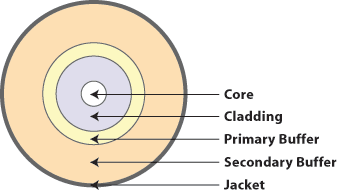Glossary
Buffer
(1) A protective Coating applied directly on the fiber. (2) A temporary storage device or circuitry which retains Data for Transmission between two equipment units, usually in order to compensate for differing data handling speeds of the units.
Primary buffer encompasses the 125um Cladding up to 250um. Secondary buffers typically buffer up to 400um or as much as 900um.
1. A routine or storage medium used to compensate for a difference in rate of flow of data, or time of occurrence of events, when transferring data from one device to another.
Note: Buffers are used for many purposes, such as (a) interconnecting two Digital circuits operating at different rates, (b) holding data for use at a later time, (c) allowing timing corrections to be made on a data stream, (d) collecting binary data bits into groups that can then be operated on as a unit, (e) delaying the transit time of a signal in order to allow other operations to occur.
2. To use a buffer or buffers.
3. An isolating circuit, often an amplifier, used to minimize the influence of a driven circuit on the driving circuit. Synonym: buffer amplifier.
4. In a Fiber optic communication cable, one type of component used to encapsulate one or more optical fibers for the purpose of providing such Functions as mechanical isolation, protection from physical damage and fiber identification. Note: The buffer may take the form of a miniature conduit, contained within the Cable and called a loose buffer, or loose buffer tube, in which one or more fibers may be enclosed, often with a lubricating gel. A Tight Buffer consists of a polymer coating in intimate Contact with the Primary coating applied to the fiber during manufacture.

